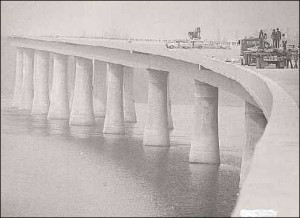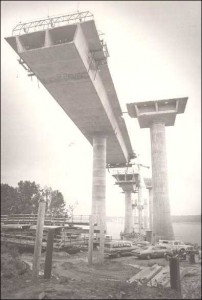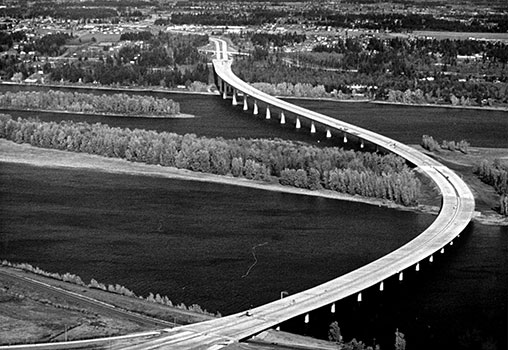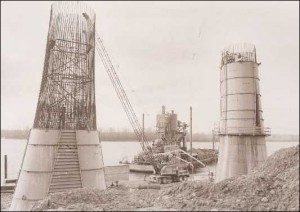The long-awaited Interstate 205 Glenn Jackson Bridge opened with a trickle of traffic shortly after noon today after Govs. John Spellman and Victor Atiyeh had knotted two flashy ribbons in a brief ceremony.
An hour later, at 1:10 p.m., traffic began flowing south behind Washington State Patrol cars.
The bridge cost $175 million and the lives of three construction workers. It is expected to carry 27,000 cars a day this year and to have profound effects on the future development of eastern Clark and Multnomah counties.
The first authorized public use of the span came at 5:45 a.m. today when a C-Tran bus crossed.
This afternoon, following the brief ceremony in the cold and rain, the opening of the span to autos was delayed while construction workers completed installation of a navigation light on the span at the state line.
Officials had prepared for an early rush of traffic, but fewer than three dozen private vehicles were lined up on either side of the bridge to win the honor of being first across when the officials got back on four buses and headed for a luncheon at the Jantzen Beach Thunderbird.
First in line from the Washington side was Theresa Bichsell, 56, of Canby, Ore., who said she had worked on the bridge. First in line on the Oregon side, in a 30-foot motor home, were John and Ethelyn Zigler of Parkrose Heights, Ore., who had talked their way through police barricades three hours earlier.
The pack of 100 vehicles waiting on the Washington side to head south included three bikers led by Slinky Jones of Vancouver, an officer of the Gypsy Jokers, who looked in vain for a flag to carry across the bridge. He was joined by another Gypsy Joker and a member of the Rude Brothers.
The first accident on the new bridge occurred shortly before 1 p.m. when Scott Skeans, 18, of Vancouver, failed to set his emergency brake and his car rolled ahead into another vehicle. Damage was negligible.
 The ribbons – green and white for Washington, blue and gold for Oregon – were knotted at 12:02 p.m., and the first Oregon-side contingent hit Washington at 12:10. Washington State Patrol troopers held back the Washington contingent until just after 1 p.m. to give all official cars and construction vehicles time to clear the bridge and to await the installation of the navigation light. Oregon officials also shut off traffic on their side after the first bunch of cars had crossed.
The ribbons – green and white for Washington, blue and gold for Oregon – were knotted at 12:02 p.m., and the first Oregon-side contingent hit Washington at 12:10. Washington State Patrol troopers held back the Washington contingent until just after 1 p.m. to give all official cars and construction vehicles time to clear the bridge and to await the installation of the navigation light. Oregon officials also shut off traffic on their side after the first bunch of cars had crossed.
Those waiting on the Washington side were in a good mood despite the cold rain, talking to one another about the importance of the event and gawking at the bikers. When finally released, they honked their horns and flashed their lights as they headed across the bridge at 30 mph behind the patrol cars.
Three C-Tran buses had carried the first public traffic across the bridge in darkness this morning to mark a new era in the Washington-Oregon transportation network.
Finally, after nearly 30 years of planning, building and occasional bickering, the Columbia River between Clark and Multnomah counties has been spanned a second time. Finally, commuters have an alternative to the aging I-5 crossing.
Seventeen years after the turn of the century, the first of I-5’s twin spans opened with much hoopla. Seventeen years before the end of the century, I-205 opened in a more reserved manner. The ribbon-typing ceremony had been scheduled for 12:30 p.m., but the officials speeded things up because of the foul weather.
About 200 people huddled under umbrellas as the knots were tied.
“I have not seen enough ribbons tied like this,” Spellman said. “I would like to see more.”
With that, the sodden assemblage got back on the buses and headed south across the bridge toward the warmer, drier confines of the Thunderbird.
Officials worried a lot about morning traffic jams that might be caused by sightseers, but that never happened. There were several tie-ups on the older Interstate 5 Bridge during the morning, however, particularly in the southbound lane. At 11:30, traffic westbound on state Highway 14 was backed up nearly a mile by a car stalled on the bridge.
The public was not invited to today’s doings, dubbed the “builders day” by organizers. Politicians, bureaucrats and engineers were there in force, however.
May 15, 1983, is to be the date of the “Columbia Crossing” people’s day, which planners promise will be free of speeches and backslapping – and packed with running races and other frivolous excuses to close the bridge to traffic for the day.
In the meantime, the bridge is expected to carry 27,000 vehicles a day. Some 20,000 will be siphoned from I-5 – no doubt motorists very willing to use the wider, less-crowded lanes to save time and frustration.
I-205 south to the Banfield Freeway (I-84) also was opened today. There are interchanges at Airport Way, Columbia Boulevard and the Banfield Freeway (I-84) westbound. To reach eastbound I-84, motorists must detour off the freeways for a short stretch.
It still is not possible to travel the length of I-205, which starts at 134th Street in Hazel Dell, skirts Vancouver and Portland on the east and rejoins I-5 in the Tualatin area nearly 40 miles to the south.
The reason: The stretch of freeway near the Rocky Butte Jail (near the Banfield) is not complete. That will be done before summer next year, but the question of whether the freeway can open before jail prisoners are moved to a new facility in downtown Portland has not been settled.
If not, it will be late next year before the freeway is opened. The whole matter is certain to trigger heated debate – no stranger to the 30-year battle to lay a ribbon of concrete around Vancouver and Portland and decorate it with a bow called the I-205 Bridge.
It’s a fact: I-205 Bridge ready
From The Columbian Dec. 12, 1982

The First of a New Generation finally is ready. Steel has been placed, piling driven, concrete poured and reinforcing cable tightened to give
the Interstate 205 Bridge its strength and graceful shape. About 1 p.m. Wednesday, Washington and Oregon dignitaries will symbolically join a ribbon near the bridge’s north end to mark the opening of the eight lane structure.
It has been more than five years since the first shovel of dirt was turned. Some $175 million has been spent; three workers gave their lives in the process.
An engineering trade journal reported in 1981 that the bridge is the “first in a new

generation” of large bridges in this country being constructed segment by segment. Others are being built.
Opening: Cars first use bridge Wednesday, December 15, 1982, after 1 p.m. ceremony. Buses use it all day. Bikeway unfinished,closed.
Length: 11,750 feet. North channel section, 7,460 feet; GovernmentIsland, 1,170 feet; south channel, 3,120 feet.Configuration: Twin spans joined by 9-foot bike/walk way. Four 12-foot-wide vehicle lanes with 10 foot shoulders each way.
Ship channel: 469 feet of north channel horizontal clearance for 300-foot-wide channel; 144 feet vertical clearance at low water.
Planning: Began in 1950s. Put into intersate 205 plan, 1964. Oregon and Washington sign design, constructions pact, October 1969. Groundbreaking, August 1977.
Concrete: 320,000 cubic yards.
Tragedy: William J. Kenneday, 32, Washougal, died after falling frombridge pier, March 1979. Louis Gregory, 21, Woodburn, Ore., andRobert Kirby, 32, Vancouver, died in crane collapse, December 1980.
Embankment: 250,000 cubic-yards.
Reinforcing steel: 21,000 tons.
Rip rap: 60,000 cubic yards around piers.
Steel piling: 280,000 lineal feet (53 miles).
Name: Glenn L. Jackson Memorial Bridge, after the powerful, late Oregon businessman and Oregon Transportation Commission head.
Contractors: Willamette Western (now Riedel International) alone and in a joint venture with Alaska Constructors and General Construction Co.; Peter Kiewit Sons’ Co.; joint venture of S.J. Groves, Guy F. Atkinson; and Ball, Ball and Brosamer.

